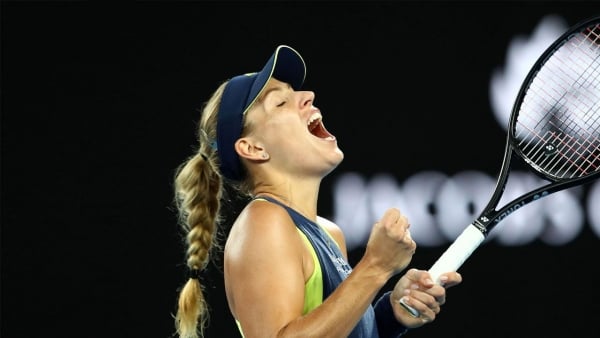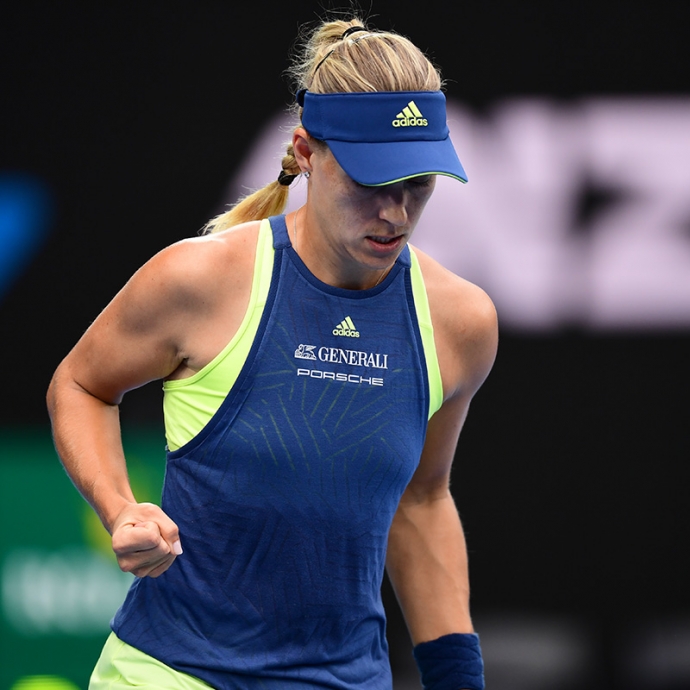Let’s just forget 2017 ever happened. It’s working a treat for Angelique Kerber right now.
When the German returned to defend her Australian Open crown as world No.1 last season, a fourth-round drubbing was only the beginning of a horror stretch that sent her tumbling from her perch at the top.
If Kerber was looking for a statement victory to announce she was truly back, then she may have just delivered it on Saturday night, romping to a 6-1 6-3 triumph over fellow former world No.1 Maria Sharapova at Rod Laver Arena.
MORE: All the latest scores and results
That’s a 12-0 start to 2018 having reached the Hopman Cup final, and after she claimed her first title since the 2016 US Open in Sydney.
This though, was a clash between two marquee names in prime time on a Grand Slam arena.
It was billed as the tussle between the last remaining former Australian Open champions in the draw, both former world No.1s and multiple slam winners, both mounting comebacks after an annus horribilis in 2017.
“I’m just so happy it’s 2018 and not 2017 anymore,” Kerber beamed upon sealing her passage into the fourth round.
“I learnt a lot from the last 24 months. Everybody who knows me knows I never give up, I always come back.”
That fourth-round defeat to Coco Vandeweghe at Melbourne Park last year was only a hint at the disastrous season about to unfold for the recently-turned 30-year-old.
At the height of her crisis of confidence, she went on to crash out against Naomi Osaka in the first round of her US Open title defence.
Something had to give. She parted ways with her coach of five years, Torben Beltz in November. In came Kim Clijsters’ former coach, Wim Fissette.
The turnaround since the off-season has been profound.
“It's a new voice who is speaking to me,” Kerber said. “I think I needed the change and that's why I decide to change everything. I think it was a good decision to do it.
“For me, it's important to speak German, which is my first language. So this is for me much easier. He's speaking German, so that was actually my first choice. He agreed.”
Against Sharapova, she set the tone for the match early when she broke for 1-0 with her combination of relentless retrieving and deep shots on the offence from near-crouch position.
Down a double break in a flash, Sharapova – who had taken down her US Open conqueror 15th seed Anastasija Sevastova in the previous round – attempted a foray to net in a desperate bid to change it up and stem the bleeding of games. It was to no avail. The German rolled a forehand pass crosscourt to bring up three set points, and the set was over in under half an hour.
If the unseeded Sharapova was to mount a serious challenge, she had to better balance her crash-through approach, which at this point was a whole lot of crash.
A double fault had the Russian staring down break points early in the second set, and another wild error long saw her trailing 2-0.
Just when it appeared Kerber was doing it in a canter, Sharapova capitalised on a few uncharacteristic errors to get back on serve for 1-2, and for the first time in the match a flicker of belief was sparked.
Where the Kerber of 2017 could very well have crumbled, the Kerber of 2018 quickly stifled that flicker as she toughed out a scare on serve at 3-3 and broke the following game.
A forehand winner soon brought up three match points, and her statement victory was complete two points later when Sharapova ripped a backhand wide.
That passion for the game has been reignited. It returned the moment she stepped on court to begin her pre-season.
“I take a lot more weeks off than usually,” Kerber said. “I said to myself I'm just going on court again, I'm really feeling it again, where I know that I have a lot of rest.
“When I walk on the court [for] my pre-season, the first day I felt it again that I will work hard to come back and playing good tennis again, enjoying it.”
The Kerber of 2016 is surging back in a hurry. Those closest to her know she never really doubted she could turn it around.

